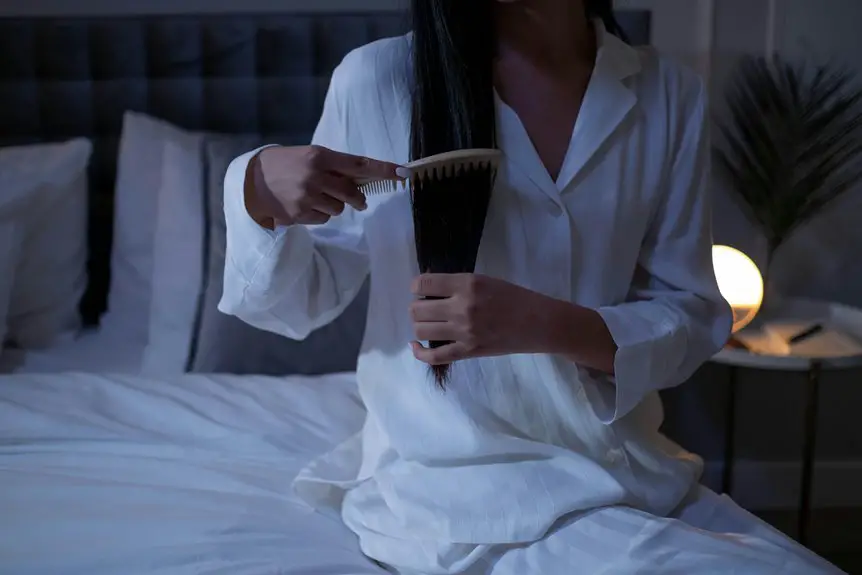To use a fabric comb for pilling removal, hold it at a slight angle and start at the hem or a less visible area. Use short, swift strokes to lift the pills without pulling on the fabric. Make sure you don’t press too hard, as that can damage the fibers. Regularly clean your comb to keep it effective. For additional tips on garment care and pilling prevention, keep exploring more strategies.
Table of Contents
Key Takeaways
- Hold the fabric comb at a slight angle to glide smoothly over the fabric’s surface.
- Start combing from the hem or a discreet area to test your technique.
- Use short, swift strokes to lift pills without tugging on the fabric.
- Avoid applying too much pressure to prevent damaging the fibers.
- Regularly clean the comb to ensure it remains effective during use.
Understanding Pilling: What Causes It?
Pilling can be a frustrating issue for fabric lovers, as those tiny balls of fuzz can make your favorite garments look worn out.
So, what causes this pesky problem? Pilling occurs when fibers in the fabric loosen and tangle together, forming those annoying little balls. This usually happens due to friction, whether from regular wear, washing, or even just rubbing against other surfaces.
Some materials, like wool and polyester, are particularly prone to pilling. You’ll notice it more in high-friction areas, like under the arms or along seams.
Understanding these causes can help you take better care of your clothes and minimize pilling in the future. By choosing the right care methods, you can keep your garments looking fresh and new.
Choosing the Right Fabric Comb
When it comes to choosing the right fabric comb, you need to take into account the type of fabric you’re working with.
Not all combs are created equal; the material of the comb can greatly affect its performance.
Fabric Types Consideration
Choosing the right fabric comb can make all the difference in effectively tackling pilling, especially since different fabric types react uniquely to wear and tear. When you consider the fabric, you’ll find that some combs work better than others.
Here’s a quick guide to help you choose:
| Fabric Type | Recommended Comb Type |
|---|---|
| Wool | Fine-toothed comb |
| Cotton | Medium-toothed comb |
| Synthetic | Wide-toothed comb |
| Cashmere | Soft, delicate comb |
Comb Material Selection
While considering the best comb for removing pilling, the material of the comb plays a crucial role in its effectiveness and durability.
You’ll find fabric combs made from various materials, including wood, plastic, and metal. Wooden combs are gentle on delicate fabrics and add a touch of elegance, but they may not be as durable.
Plastic combs are lightweight and often more affordable, but their effectiveness can vary.
Metal combs tend to be the most durable and provide a thorough pilling removal, ideal for tough fabrics.
When selecting a comb, consider your fabric types and how often you’ll use it. Choosing the right material guarantees you’ll effectively tackle pilling while protecting your garments.
Preparing Your Garment for Pilling Removal
Before you start tackling pilling on your favorite garment, it’s essential to prepare it properly to guarantee the best results.
First, lay the garment on a flat, clean surface to avoid damaging it. Check for any loose threads or damages; if you find them, consider repairing those areas before you proceed.
Next, make certain the fabric is clean and dry. Washing the garment can help remove any dirt or oils that might interfere with the pilling removal process.
If possible, iron the garment lightly to smooth out wrinkles, as this will make it easier to work on.
Taking these steps will assure your pilling removal efforts are as effective as possible, leaving your garment looking fresh and revitalized.
The Proper Technique for Using a Fabric Comb
Now that your garment is prepped and ready, it’s time to focus on the proper technique for using a fabric comb effectively.
Start by holding the comb at a slight angle to the fabric, ensuring it glides smoothly over the surface. Begin at the hem or a less visible area, gently drawing the comb over the pills. Use short, swift strokes to lift the pills without pulling the fabric.
Avoid pressing too hard, as this can damage the fibers. After you’ve removed the pills from one section, check for any remaining spots before moving on.
Remember to clean the comb regularly to maintain its effectiveness. This technique will help keep your garment looking fresh and new.
Tips for Effective Pilling Removal
When it comes to removing pilling effectively, choosing the right fabric for your comb makes a big difference.
You’ll also want to use gentle pressure to avoid damaging your clothes, and don’t forget to clean the comb regularly for the best results.
These simple tips can help keep your garments looking fresh and new.
Choose the Right Fabric
Although pilling can occur on various fabrics, choosing the right material can greatly reduce its appearance and frequency. Here are some tips to help you select fabrics that resist pilling:
- Opt for Synthetic Blends: Fabrics like polyester and nylon tend to be more resistant to pilling than natural fibers. They hold up well against wear and tear.
- Look for Tight Weaves: Fabrics with tighter weaves are less likely to develop pills. Cotton or wool with a dense structure can be a better choice.
- Consider Fabric Finishes: Some fabrics come with protective finishes designed to minimize pilling. Always check labels for such treatments.
Use Gentle Pressure
Choosing the right fabric can greatly impact your experience with pilling, but when it does occur, using gentle pressure is key to effective removal. Applying too much force can damage your fabric, leading to snags or tears. Instead, lightly glide the comb over the surface, allowing it to catch the pills without aggression.
Here’s a quick reference for applying gentle pressure:
| Action | Description | Result |
|---|---|---|
| Light Glide | Move the comb slowly across fabric | Removes pills gently |
| Short Strokes | Use brief, controlled motions | Minimizes damage |
| Consistent Touch | Keep pressure even | Protects fabric integrity |
Clean the Comb Regularly
To guarantee effective pilling removal, you should clean the comb regularly, as this simple step can greatly enhance its performance. A dirty comb can redistribute lint and pills back onto your fabric, defeating your efforts.
Here’s how to keep your comb in top shape:
- Remove Debris: After each use, gently pull off any collected fibers or lint. This prevents buildup.
- Wash with Soap: Occasionally, wash the comb with warm soapy water to eliminate oils or residues. Rinse and dry it thoroughly.
- Inspect for Damage: Regularly check for bent or broken teeth. A damaged comb won’t work effectively, so replace it if necessary.
Caring for Your Fabric Comb
Caring for your fabric comb is essential to guarantee it remains effective and lasts longer. After each use, inspect the comb for any debris or lint, and remove it carefully.
Store your comb in a dry place, away from moisture, to prevent rust or damage. Avoid placing heavy items on top of it, as this may distort its shape.
If your comb has wooden components, consider applying a light coat of mineral oil occasionally to keep the wood conditioned. Regularly check for any signs of wear or damage, and replace it if necessary.
Alternatives to Fabric Combs for Pilling Removal
While a fabric comb is a popular choice for removing pilling, several alternatives can effectively tackle those pesky fuzz balls. You might find these options handy:
- Lint Rollers: Simply roll a sticky lint roller over the fabric to lift away pills and lint quickly.
- Pumice Stone: Lightly rub a pumice stone over the fabric surface. Its rough texture can pull off pills without damaging the fabric.
- Scissors: For larger pills, carefully snip them off with a pair of small scissors. Just be cautious not to cut the actual fabric.
These alternatives can be just as effective, ensuring your clothes look fresh without the need for a fabric comb.
Give them a try next time you notice pilling!
Maintaining Your Clothes to Prevent Future Pilling
Maintaining your clothes properly can greatly reduce the chances of pilling, ensuring they stay looking new for longer.
Start by washing your garments inside out to minimize friction. Use a gentle cycle and cold water, which helps preserve fibers. Avoid overloading the washing machine; this can cause clothes to rub against each other excessively.
When drying, opt for air-drying or a low-heat setting, as high heat can weaken fibers.
Additionally, choose your fabrics wisely; natural fibers like cotton and wool are less prone to pilling than synthetics.
Store your clothes in a cool, dry place, and avoid hanging delicate items, which can stretch and lead to pilling.
Frequently Asked Questions
Can Fabric Combs Damage Delicate Fabrics Like Silk or Wool?
Yes, fabric combs can damage delicate fabrics like silk or wool if used too aggressively. You should always test on a small area first and use gentle strokes to avoid pulling or tearing the fibers.
How Often Should I Use a Fabric Comb on My Clothes?
You should use a fabric comb whenever you notice pilling on your clothes, typically after several wears or washes. Regular maintenance can keep your garments looking fresh, but avoid overdoing it to prevent fabric damage.
Are There Specific Fabrics That Should Never Be Combed?
You should avoid combing delicate fabrics like silk or lace, as they can easily get damaged. Instead, focus on sturdier materials like cotton or wool, which can handle the treatment without losing their integrity.
Can I Use a Fabric Comb on Knitwear?
Yes, you can use a fabric comb on knitwear. Just be gentle to avoid damaging the fibers. Always test a small area first to guarantee it doesn’t affect the texture or appearance of your garment.
Is It Safe to Use a Fabric Comb on Vintage Garments?
You can use a fabric comb on vintage garments, but be cautious. Test it on a small area first, and avoid applying too much pressure to prevent damage. Preserve the fabric’s integrity while removing those pesky pills.
- Does Chiffon Fabric Stink - July 15, 2025
- Does Chiffon Fabric Affect the Economy - July 15, 2025
- Does Cotton Fabric Have a Nap - July 15, 2025







